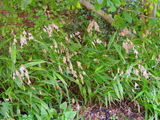Native Plants

Q. Who is Mr. Smarty Plants?
A: There are those who suspect Wildflower Center volunteers are the culpable and capable culprits. Yet, others think staff members play some, albeit small, role. You can torture us with your plant questions, but we will never reveal the Green Guru's secret identity.
Did you know you can access the Native Plant Information Network with your web-enabled smartphone?
Ask Mr. Smarty Plants is a free service provided by the staff and volunteers at the Lady Bird Johnson Wildflower Center.

rate this answer
Saturday - January 05, 2008
From: San Antonio, TX
Region: Southwest
Topic: Grasses or Grass-like
Title: Post freeze care for Texas native grasses
Answered by: Barbara Medford
QUESTION:
Can you tell me the best post-freeze care for Tx native grasses in my garden: lindheimer muhly, gulf muhly, inland sea oats. Mexican feather grass. Do I cut them back? Burn them? Leave them alone? Thank you.ANSWER:
The key word in your question is "native." When you select plants that are already adapted to an area, it cuts down on the maintenance that has to be done. Muhlenbergia lindheimeri (Lindheimer's muhly), Muhlenbergia capillaris (hairawn muhly), Chasmanthium latifolium (Inland sea oats), and Nassella tenuissima (finestem needlegrass) are all native to this area, and will suffer little, if any, from frost. With all grasses, the main concern in trimming is keeping them tidy. It's probably best to leave any dead stems on the grasses until the chances of frost are well over, as the overhanging grasses will help to protect the green part of the plant from an excessive freeze. Then, you might cut about 1/3 of the plant back, and thoroughly rake out any dead or cut ends. Keeping the dead grasses out of the plants is important both to appearance and because the dry material can be a burn hazard. Obviously, we do not advise that you burn anything, especially now with the dry weather in Central Texas, along with high winds.
More Grasses or Grass-like Questions
Creating a wildflower meadow
May 18, 2013 - I have an area 1-6 acres worth that is currently grass that I would like to overseed with wildflower seed. The local native plant nursery says that would be a waste. I don't really want to kill gra...
view the full question and answer
Need name of company with experience in Habiturf installation in Round Rock, TX.
January 24, 2012 - Dear Mr. Smarty Plants,
I read the article about "NATIVE LAWNS: HABITURF™ A MULTI-SPECIES MIX FOR NORTH, WEST AND CENTRAL TEXAS"
Do you know any landscape companies/groups in Austin - Round Ro...
view the full question and answer
Plants for streambank area in Oregon
September 14, 2012 - I am ready to replant a streambank area with native plants..what do you recommend for the Willamette Valley in Oregon? Thanks much!
view the full question and answer
Native grasses for shady yard in Austin
September 04, 2011 - I was looking at your research on native grasses to be used in a yard. I want to plant your native mix of seeds, but worry that there is too much shade in my yard. I live in central Austin and wante...
view the full question and answer
Clearing up the nativity of so-called Baltimore sedge (Carex senta)
November 12, 2009 - Dear Smarty Pants: Hi, did you ever get more clarity on the Carex senta issue (baltimore sedge)? Whether or not it was a wetland grass? I too am in Maryland and was thinking of planting it for a law...
view the full question and answer
| Support the Wildflower Center by Donating Online or Becoming a Member today. |

